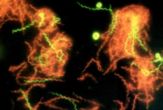
Scientists have discovered a novel genetic repair process that allows a hardy desert microbe to die and resurrect over and over again.
The finding, detailed in the Sept. 28 issue of the journal Nature, could lead to new forms of regenerative medicines and might even allow scientists to one day bring dead cells in our own bodies back to life.
Deinococcus radiodurans is a so-called extremophile bacterium that can survive intense bouts of heat and UV radiation that shatters its genome into hundreds of DNA fragments. Without a genome, the microbe is effectively dead because it can't synthesize the proteins necessary for life.
In only a few hours, though, Deinococcus can reassemble its genome and return to life.
"This is the first case, I think, of a living cell that clinically dies—its DNA is chopped into little pieces and it has no metabolism—when desiccated, and yet, as long as it can reconstitute its genome, it reconstitutes its own life," said study team member Miroslav Radman of Paris University in France.
The microbe is able to perform its remarkable feat because, like other bacteria, it carries at least two, sometimes more, copies of its genome and also because radiation damages DNA randomly. So even if both genome copies are damaged, they likely aren't damaged in the same spots. With the right tools, a microbe can piece together what the original sequence was.
Returning to life
Sign up for the Live Science daily newsletter now
Get the world’s most fascinating discoveries delivered straight to your inbox.
Here's how it works: When it initially shatters, Deinococcus' genome is broken apart into numerous double-stranded DNA fragments. Proteins chew away at the ends of the fragments, creating overhanging single-stranded DNA "tails." The tails are called "sticky-ends" because they can combine with each other. To work, the sticky-ends have to contain complimentary DNA sequences.
DNA is made up of four bases, or "letters," that combine in specific ways: A always pairs with T and G with C. So if the sequence on one tail is ATG, it can pair with another tail whose sequence is TAC. Two complimentary sticky ends will naturally fit together like toy Lego blocks.
The sticky-ends allow sequential DNA fragments to be joined together to form linear, double-stranded intermediate pieces. A protein then arranges the double-stranded pieces into the types of circular chromosomes which are characteristic of bacteria.
"Once the genome is reconstituted, the cell can synthesize [again] all of its proteins, lipids and membranes and the cell resurrects," Radman said.
Potential human applications
Although the basic mechanism behind Deinococcus' hardiness is understood, many mysteries still remain. For one, proteins are needed for DNA repair and synthesis, but proteins can be damaged by radiation, too. It's one thing to piece together a broken genome, but how does Deinococcus do it with broken tools?
"That's still a mystery," Radman told LiveScience. "How, after months of desiccation and burning from UV sunlight in the desert, is there still sufficient protein activity to start reconstituting DNA? We don't know."
One possibility is that Deinococcus' proteins are resistant to dehydration sort of like how proteins in thermophile bacteria are resistant to temperature.
Radman believes his team's findings open up the possibility of resurrecting dead cells in our own bodies, specifically those in our brains.
"It allows us now, legitimately, to dream of bringing back to life dead or close to dead neurons," he said.
Unique strategy
Unlike most bacteria studied in biology, such as E. coli and salmonella, Deinococcus is a slow grower. It didn't evolve to divide rapidly, but to be robust.
"It sort of went the other way of capitalism—it doesn't care about growth and fast division because it doesn't need to compete in the desert with anybody," Radman said. "So in that sense, Deinococcus is the bacterial paradigm of neurons, which [usually] don't divide during our lifetimes."
Like Deinococcus, neurons carry two—albeit slightly different—copies of their genomes: one from Mom and the other from Dad. In fact, all the cells in our bodies except sperm and egg contain two genome copies. Therefore, it's possible that one day scientists could resurrect dead neurons using repair mechanisms similar to those employed by Deinococcus, Radman said.
"Deinococcus has found a way of putting its genome back together, and in that sense, could ring a bell for regenerative medicine in the future," he said.










